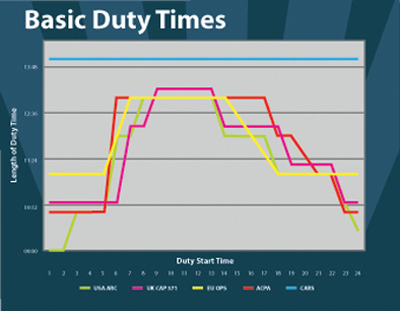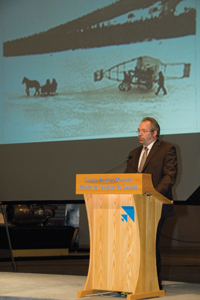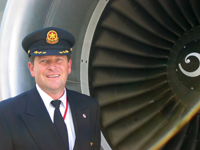
Features
Safety
Catching up to fatigue
At 3:54 a.m. on Oct. 14, 2004, an MK airlines B-747-200 freighter taxied for take-off at Halifax, bound for Spain.
November 4, 2010 By DAVID OLSEN
At 3:54 a.m. on Oct. 14, 2004, an MK airlines B-747-200 freighter taxied for take-off at Halifax, bound for Spain. Minutes later the 350 tonne aircraft overshot the runway, hit the ILS antenna and disintegrated in flames, killing all seven crew. The 2006 Transportation Safety Board (TSB) report was blunt – citing crew fatigue as a major causal factor. The flight crew had been awake for at least 19 hours at the time of the crash, performing take-off calculations during their Window of Circadian Low (WOCL – period between 0200 and 0559). The crew failed to enter the Halifax take-off weight into the computer, which still contained the data from departure at Bradley, Connecticut – 110,000 kg less than the take-off weight at Halifax. Thus, the power settings and V speeds were incorrect and the fatigued crew, taking-off in the dark with reduced situational awareness were doomed. The cockpit voice recorder was destroyed, so we will never know the crew reactions to the deadly events in those final seconds.

|
|
| Captain Martin Gauthier is flight-time/duty-time committee chairman of the Airline Pilots Association (ALPA) of Canada. PHOTO: alpa |
Since then, there has been major progress on flight and duty time limitations (FDTL), including Transport Canada (TC) proposals for Fatigue Risk Management Systems (FRMS) for AMOs and published FRMS guidance material. However, this is no time for political catch phrases such as “a made in Canada solution” and Capt. Barry Wiszniowski, Technical and Safety Chair of the Air Canada Pilots Association (ACPA), stresses “fatigue is universal – all pilots have the same circadian rhythm and window of circadian low, wherever they are.”
In 2004, the U.K. Civil Aviation Authority (CAA) published CAP 371 (The Avoidance of Fatigue in Aircrews — Guide to Requirements) — regarded by pilot groups like ALPA as the “best in the world.” The science-based provisions of CAP 371 are requirements which have been in force for more than six years, so it is reasonable for pilots to ask, “If the British can do it, why not us?”
Effective November 2009, ICAO Annex 6 required that flight time, flight duty periods, duty periods and rest period regulations for flight and cabin crew members, shall be based on scientific principles and knowledge. Pilots worldwide were enthusiastic. “European pilots strongly welcome this amendment” said Philip Von Schoppenthau, secretary general of the European Cockpit Association (ECA), representing 38,200 pilots, adding “So far, EU member states and institutions have shied away from mustering the political will to base Europe’s pilot fatigue rules on sound scientific evidence.” European FDTL regulations – EU-OPS-subpart Q, came into force in 2008, but, unlike ICAO and U.K. CAP 371, do not mention acclimatization to local time. The European Air Safety Group expressed concern at the “ambiguities, inconsistencies, flaws and anomalies,” noting subpart Q is “incomplete in important areas” and compared it unfavourably with the advanced approach of CAP 371 which remains in force until EASA establishes EU rules based on scientific knowledge and best practices. This should happen in 2012 when new rules come into force, incorporating all amendments to ICAO Annex 6.
 |
|
| In Canada (CARs), the length of duty time is the same, no matter what hour of the day you start (even if you start during the WOCL). Other jurisdictions take into account circadian and other factors to determine the allowable duty time.
|
The Colgan Air disaster in 2009 concentrated minds in the U.S. Congress and FAA. After the NTSB report, the FAA expedited a review of FDTL rules and an Aviation Rule-making Committee (ARC) was charged with producing recommendations for a science-based approach to fatigue management by Sept. 1, 2009. Subsequently the FAA published a Notice of Proposed Rule Making (NPRM) in September 2010, drawing heavily on the provisions of U.K. CAP 371, and in July 2010 issued Advisory Circular 120-100 on Aviation Fatigue. Captain Martin Gauthier, flight-time/duty-time committee chairman of the Airline Pilots Association (ALPA) of Canada, sees advantages in the FAA system, since ARC had 45 days to produce recommendations, whereas the CARAC WG has 12 months.
In November 2011, ICAO Annex 6 will incorporate FRMS into ICAO Standards, require states to establish prescriptive fatigue regulations based on scientific principles, and establish FRMS regulations if they authorize operators to use FRMS. This leaves Canada with some catching-up to do. Martin Eley became director general, civil aviation (DGCA) Canada in 2009 and has charted a new course for FDTL regulations. “This is a priority issue” says Eley. “We recognize there is work to be done.” He has set up a CARAC Flight Crew Fatigue Management (FCFM) Working Group, charged with making recommendations on science-based FDTL and FRMS while ensuring that prescriptive regulations reflect current thinking. “Existing regulations,” he says, “were based on the best knowledge available at the time and the first priority is to get a good sense of what is needed to update Canadian regulations in the context of ICAO SARPs and initiatives in Europe and the U.S.”
Eley recognizes that new regulations will have to cater to all operators and “Although FRMS is clearly the way to go, some operators may prefer to work with the simplicity of prescriptive regulation alone.” He contends the system has worked fairly well, but “We need to bring it up-to-date; fundamentally, it is down to priorities and we have had to do a lot of work on CARs, such as implementing SMS. Fatigue is now at the top of our priority list, which is why we have initiated the working group.”
 |
|
| Martin Eley became director general, civil aviation (DGCA) Canada in 2009. PHOTO: TRANSPORT CANADA |
“Clearly, there are advantages to FRMS in terms of taking account of all aspects of fatigue because it goes beyond just the duty time and looks at many more things,” Eley says. “We think as it evolves, becomes better understood and consistently applied, it will deal with some of the issues we see in regional operators, where schedules are less well defined, and there tend to be long working days in the current environment.”
TC planned to introduce FRMS requirements for AMOs into CAR 573 as part of SMS because “we think the company culture that develops with SMS is the sort of culture you need for FRMS to be practical” Eley says. “We are not holding it back – it is just our ability to work through the Gazette process.”
ACPA’s Barry Wiszniowski believes safety should not have to be part of union contracts. At the Canadian Aviation Safety Network in May 2009, ACPA and ALPA highlighted the difference between the ICAO and European flight time limitations, and those of CARs. (refer to graph ). Currently, FDTL for Air Canada pilots is part of the ACPA contract – the only pilots in Canada whose duty times are based upon the current ICAO SARPs and similar to those in the U.K. for example. Wiszniowski emphasizes that ACPA plays an important “duty of care” role, advancing safety for users of Canada’s aviation system. Meanwhile, Air Transat and its pilots union plan to implement an FRMS if the tentative agreement is approved.
ALPA represents pilots working for several Canadian carriers, and with ACPA and four other pilot associations, sent a joint letter to TC in February 2010, requesting an expedited FDTL amendment process, which resulted in the CARAC FCFM WG. ALPA’s Gauthier points out that the only major change in CARs in 1996 was to change the 15 hours maximum duty time to 14 hours. However, he stresses it is time to look forward and, like ACPA, believes that safety and fatigue regulations should not depend on collective bargaining. “We would like a level playing field for everyone” he says.
Asked if the Colgan situation could have happened in Canada – Gauthier contends Canada also has the problem of low entry level wages and some pilots commuting – so it is possible. “That’s why we need urgency from the CARAC WG output – we are off to a good start and I am optimistic that we will reach a consensus, but let’s do it before something bad happens here.” The regulations regarding reserve pilots are also a concern for ALPA. CARs stipulate eight hours sleep in 24 hours, but are silent on when reserve pilots get called and go onto regular duty times. “In theory, you can be on reserve for 15 hours,” says Gauthier, “and then go onto a 14-hour duty time flight.”
 |
|
| ACPA’s Barry Wiszniowski believes safety should not have to be part of union contracts. PHOTO: ACPA
|
Captain Michel Chiasson of Air Canada represents the National Airlines Council of Canada (Air Canada, Jazz, Westjet and Air Transat) and has a key message; “Politicians have to give priority to the rapid adoption of new CARs, compliant with ICAO Annex 6 as it will be by November 2011.” He points to 497 NPAs stuck in the system, some there for years, and which have not reached Gazette 1. However, NACC recognizes that Martin Eley understands the importance of moving forward and is confident that the Minister supports current initiatives. NACC held a symposium on Sept. 28 and participants included ICAO FRMS task force co-ordinator Dr. Michelle Millar, Dr. Phillipa Gander from New Zealand and the co-chairs of the FAA ARC. “There is no disagreement on the science and the effect of fatigue on performance” says Chiasson — “the challenge is to structure CARs and FRMS to meet the varied operational needs of Canadian carriers while ensuring a common level of safety.”
Captain Dan Adamus is industry co-chair of the CARAC WG (the other co-chair is Jacqueline Booth of Transport Canada) which had its first meeting in August and will meet monthly throughout its 12 month mandate. At the first meeting, the group made a comparative review of the current Canadian/U.S./European regulations against ICAO SARPs and studied the June 2010 ICAO State Letter on the amendment to Annex 6, introducing FRMS.
Adamus described the first session as a positive experience for all participants and in future it is intended to have input to the WG from other countries and organizations. The WG will review FRMS and a hold a “scientist day,” so that after the first three meetings, it will have received/reviewed all information on prescriptive regulation, FRMS and the latest science, ready to move on to developing recommendations.